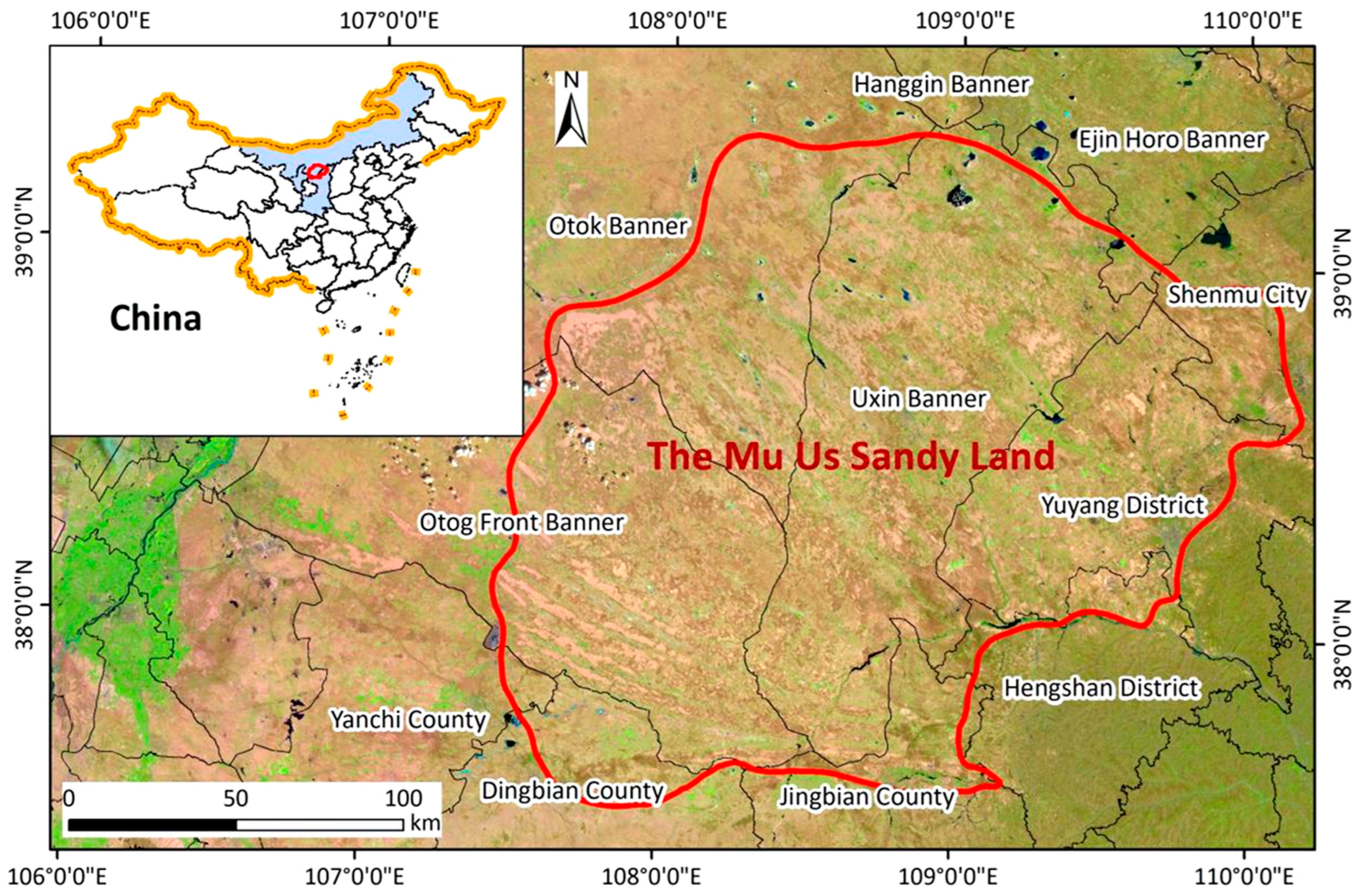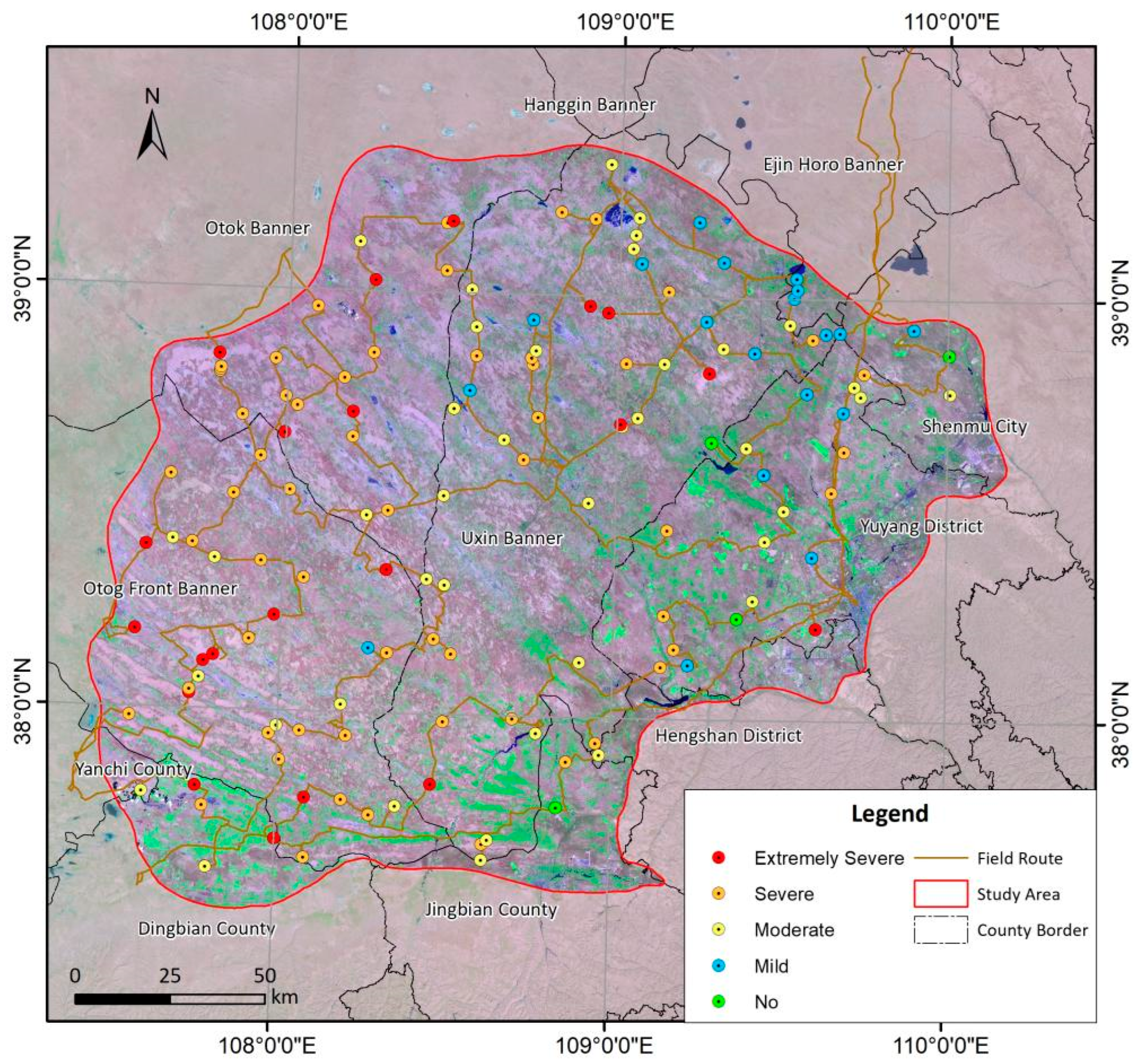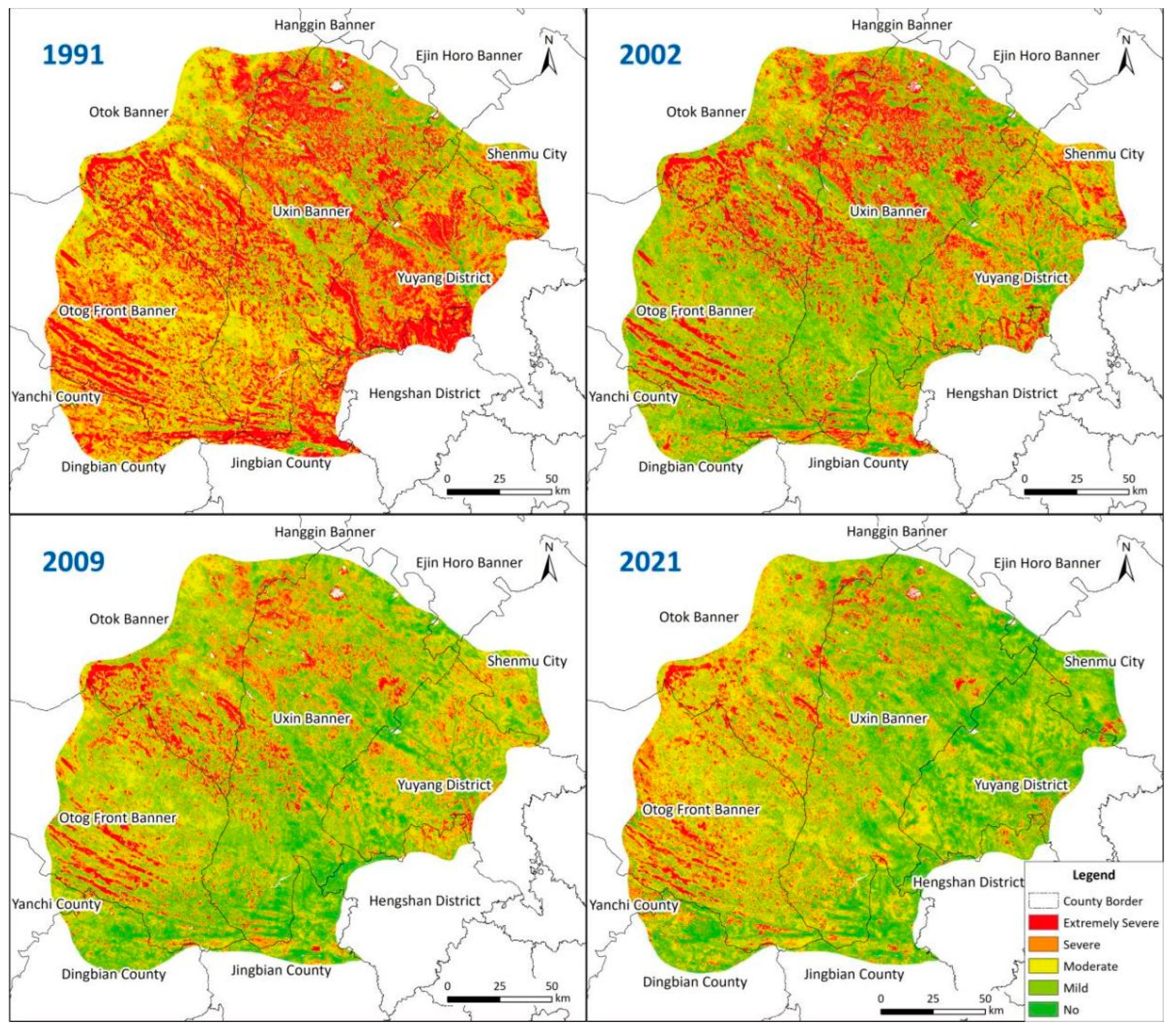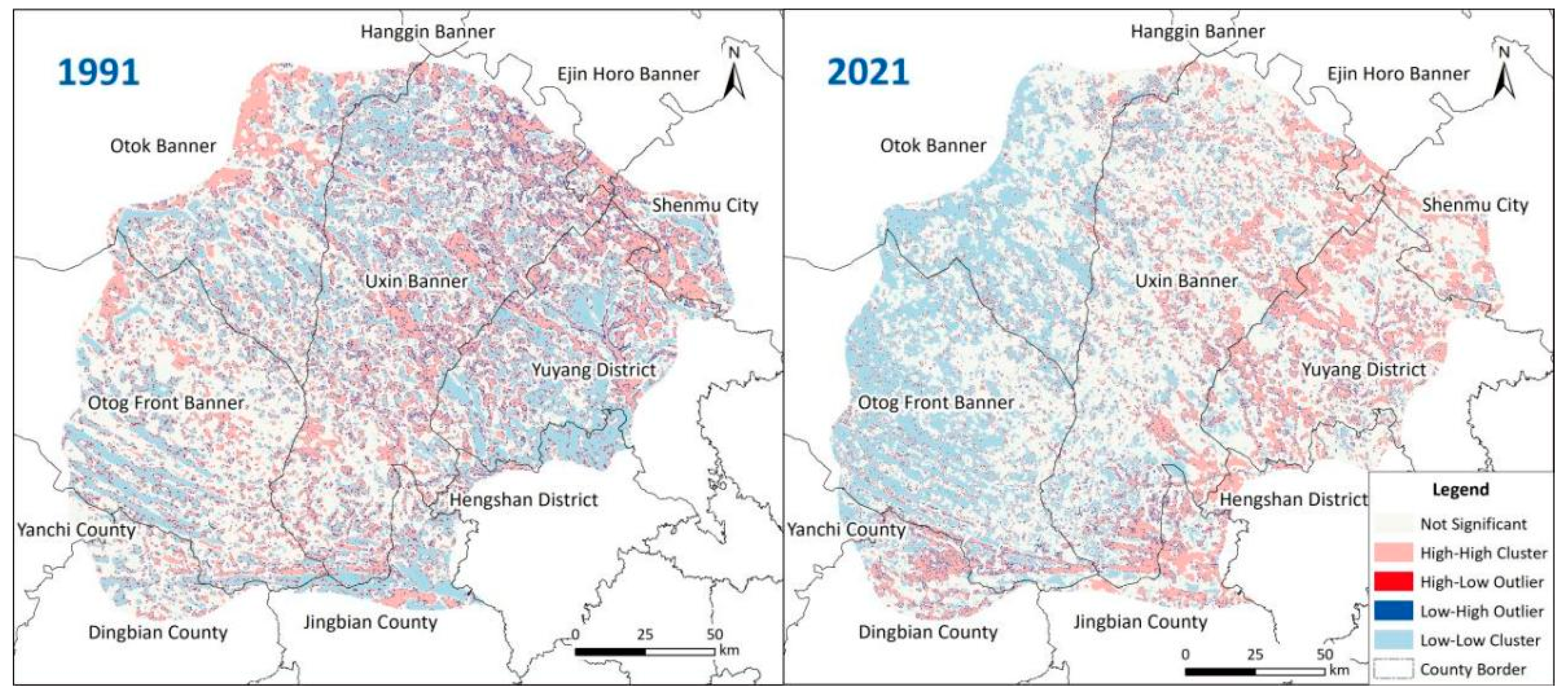Analysis of Spatial-Temporal Changes and Driving Forces of Desertification in the Mu Us Sandy Land from 1991 to 2021
Abstract
1. Introduction
2. Study Area and Data Sources
2.1. Study Area
2.2. Data Sources
- (1)
- Four Landsat images with 30 m spatial resolution were obtained from the Geospatial Data Cloud website (www.gscloud.cn, accessed on 1 December 2021), covering the whole study area. In order to accurately determine the degree of desertification of the Mu Us Sandy Land, summer images with cloud cover of less than 5% were selected. The data acquisition information is presented in Table 2.
- (2)
- Meteorological data were processed using daily meteorological data collected from 115 meteorological stations, accessed on 1 May 2022, including 9 reference stations, 31 basic stations, and 75 general stations around the study area. The data include mean annual temperature (Celsius), annual precipitation (mm), evaporation (mm), and mean annual wind speed (m/s). By using the kriging interpolation method, we mapped the spatial distribution of different meteorological indexes, with a spatial resolution of 30 m.
- (3)
- Elevation data was obtained from ASTER GDEM data archives from the Geospatial Data Cloud (www.gscloud.cn, accessed on 1 August 2021), containing 10 scenes that covered the study area. After processing, slope and aspect data of the study area were derived, with a spatial resolution of 30 m.
- (4)
- Socioeconomic data were obtained from the Ordos Statistical Yearbook from 2000 to 2021, including GDP, population, seeding area, livestock number, annual grass planting area, and annual afforestation area of Uxin Banner.
- (5)
- Field data consisted of 140 sampling points collected from the Mu Us Sandy Land in mid-July 2021 (the period of vegetation growth). Since the roots of Artemisia annularis and Salix salsa, which are most widely distributed in the study area, are relatively developed at a soil depth of 20–30 cm [36,37], soil samples were primarily collected at a depth of 20–30 cm. We collected soil nitrogen content, soil phosphorus content, soil potassium content, soil organic matter content, and soil fractal dimension for each sampling point, and then obtained raster data for each item using Kriging interpolation with a spatial resolution of 1 km.
- (1)
- Uniformity: Sampling points should be as evenly dispersed in the study area as possible. We took the 20 km × 20 km grid as the basic unit and divided the study area into several units. At least 1 field survey site should be set up in each unit.
- (2)
- Compatibility: The selection of sampling points should take into account the characteristics of the overall ecological geological conditions of surrounding grids, so as to avoid the arrangement of sampling points in similar areas, which makes it difficult to control the overall regional characteristics of the study area.
- (3)
- Typicality: Vegetation types on dunes obviously vary from the top to the bottom. Therefore, for large dunes, sampling points were arranged at the top of the dune, the waist of the dune and the interdune beach.
- (4)
- Accessibility: In order to ensure the efficiency and safety of field work, the sampling points should be placed so as not to be too difficult to reach, leading to the abandonment of the survey.
3. Methodology
3.1. MSAVI-Albedo Model Building
- (1)
- Landsat Image Preprocessing
- (2)
- Water Pixel Elimination
- (3)
- MSAVI and Albedo Calculation
3.2. Classification of Desertification Based on Albedo-MSAVI
3.3. Classification of Desertification and Field Verification
3.4. Clustering of Desertification Index
- (1)
- Global Moran’s I Statistic
- (2)
- LISA Spatial Clustering
3.5. Geographic Detector
4. Result and Discussion
4.1. Spatial Distribution of Desertification
4.1.1. Spatial-Temporal Distribution of Desertification
4.1.2. Interannual Change of Desertification
4.1.3. Desertification Cluster Distribution
4.2. Driving Factors of Desertification
4.2.1. Driving Factors of Desertification Distribution
4.2.2. Driving Forces of Desertification Change
- (1)
- Meteorological Factors
- (2)
- Human Factors
5. Discussions
5.1. Desertification Dynamic
5.2. Effects of Natural Factors on Desertification
5.3. Effects of Human Factors on Desertification
6. Conclusions
Author Contributions
Funding
Data Availability Statement
Conflicts of Interest
References
- UNCCD. United Nations Convention to Combat Desertification in Countries Experiencing Serious Drought and/or Desertification, Particularly in Africa; UNCCD: Paris, France, 1994. [Google Scholar]
- Reynolds, J.F.; Smith, D.M.S.; Lambin, E.F.; Turner, B.L.; Mortimore, M.; Batterbury, S.P.J.; Downing, T.E.; Dowlatabadi, H.; Femandez, R.J.; Herrick, J.E. Global desertification: Building a science for dryland development. Science 2007, 316, 847–851. [Google Scholar] [CrossRef]
- Zhang, Z.H.; Huisingh, D. Combating desertification in China: Monitoring, control, management and revegetation. J. Clean. Prod. 2018, 182, 765–775. [Google Scholar] [CrossRef]
- Xu, D.Y.; Zhang, X. Multi-scenario simulation of desertification in North China for 2030. Land Degrad. Dev. 2021, 32, 1060–1074. [Google Scholar] [CrossRef]
- Lu, Q.; Lei, J.Q.; Li, X.S. China’s combating desertification: National solutions and global paradigm. Bull. Chin. Acad. Sci. 2020, 35, 656–664. [Google Scholar]
- Zhu, J.J.; Zheng, X. The prospects of development of the Three-North Afforestation Program (TNAP): On the basis of the results of the 40-year construction general assessment of the TNAP. Chin. J. Ecol. 2019, 38, 1600–1610. [Google Scholar]
- Gao, Z.; Li, C.; Ci, L.; Yang, X. Engineering and Technological Measures for Combating Desertification; Higher Education Press: Beijing, China, 2010; pp. 427–463. [Google Scholar]
- National Forestry and Grassland Administration. Bulletin on the Status of Desertification and Desertification in China; National Forestry and Grassland Administration: Beijing, China, 2015.
- Lu, C.; Zhao, T.; Shi, X. Ecological restoration by afforestation may increase groundwater depth and create potentially large ecological and water opportunity costs in arid and semiarid China. J. Clean. Prod. 2018, 176, 1213–1222. [Google Scholar] [CrossRef]
- Cao, S. Impact of China’s large-scale ecological restoration program on the environment and society in arid and semiarid areas of China: Achievements, problems, synthesis, and applications. Crit. Rev. Environ. Sci. Technol. 2011, 41, 317–335. [Google Scholar] [CrossRef]
- Bryan, B.A.; Gao, L.; Ye, Y. China’s response to a national land—System sustainability emergency. Nature 2018, 559, 193–204. [Google Scholar] [CrossRef]
- Liu, X.; Lu, R.; Du, J.; Lyu, Z.; Wang, L.; Gao, S.; Wu, Y. Evolution of Peatlands in the Mu Us Desert, Northern China, Since the Last Deglaciation. J. Geophys. Res. Earth Surf. 2018, 123, 252–261. [Google Scholar] [CrossRef]
- Wang, X.; Chen, F.H.; Dong, Z.; Xia, D. Evolution of the southern Mu US desert in north China over the past 50 years: An analysis using proxies of human activity and climate parameters. Land Degrad. Dev. 2005, 16, 351–366. [Google Scholar] [CrossRef]
- Ding, Z.; Sun, J.; Liu, D. Stepwise advance of the Mu Us Desert since late Pliocene; Evidence from a red clay-loess record. Chin. Sci. Bull. 1999, 44, 1211–1214. [Google Scholar] [CrossRef]
- Wen, P.; Wang, N.; Wang, Y.; Huang, Y.; Cheng, H.; He, T. Fluvial incision caused irreversible environmental degradation of an ancient city in the Mu Us Desert, China. Quat. Res. 2021, 99, 1–13. [Google Scholar] [CrossRef]
- Feng, K.; Wang, T.; Liu, S.; Kang, W.; Chen, X.; Guo, Z.; Zhi, Y. Monitoring Desertification Using Machine-Learning Techniques with Multiple Indicators Derived from MODIS Images in Mu Us Sandy Land, China. Remote Sens. 2022, 14, 2663. [Google Scholar] [CrossRef]
- Zhu, Z.; Liu, S. Judgment on the concept of desertification and its development degree. Desert China 1984, 4, 2–8. [Google Scholar]
- Zhu, Z. The concept, causes, and control of land desertification in China. Quat. Res. 1998, 2, 145–155. [Google Scholar]
- Zhu, J.; Zhu, Z. Desertification Control in China; China Forestry Press: Beijing, China, 1999. [Google Scholar]
- Ringrose, S.; Matheson, W.; Tempest, F. The development and causes of Range Degradation Featuresin Southeast Botswana using Multi-temporal Landsat MSS Imagery. Photogrammetic Eng. Remote Sens. 1990, 56, 1253–1262. [Google Scholar]
- Hill, J.; Stellmes, M.; Udelhoven, T.; Röder, A.; Sommer, S. Mediterranean desertification and land degradation: Mapping related land use change syndromes based on satellite observations. Glob. Planet. Chang. 2008, 64, 146–157. [Google Scholar] [CrossRef]
- Afrasinei, G.M.; Melis, M.T.; Buttau, C.; Arras, C.; Zerrim, A.; Guied, M.; Ouessar, M.; Essifi, B.; Zaied, M.B.; Jlali, A. Classification Methods for Detecting and Evaluating Changes in Desertification-Related Features in Arid and Semi-arid Environments. Euro-Mediterr. J. Environ. Integr. 2017, 2, 21. [Google Scholar] [CrossRef]
- Du, Z.; Zhan, Y.; Wang, C. Dynamic Monitoring of Desertification in Horqin Sandy Land Based on MODIS NDVI. Remote Sens. Land Resour. 2009, 2, 14–18. [Google Scholar]
- Li, J.; Praseodymium, L.; Ji, L.; Dewati, A. Research on the application method of GIS based MODIS in environmental desertification monitoring. Xinjiang Meteorol. J. 2003, 2, 21–23. [Google Scholar]
- Javier, T.; Silva, P.; Barbosa, A.A.; Rodriguez, D.A.; De, O.; Sestini, M.F. Desertification trends in the northeast of Brazil over the period 2000–2016. Int. J. Appl. Earth Obs. 2018, 73, 197–206. [Google Scholar]
- Zhou, Y.Q.; Hu, Z.W.; Geng, Q.Q.; Ma, J.R.; Liu, J.Y.; Wang, M.; Wang, Y.C. Monitoring and analysis of desertification surrounding Qinghai Lake (China) using remote sensing big data. Environ. Sci. Pollut. Res. 2023, 30, 17420–17436. [Google Scholar] [CrossRef] [PubMed]
- Zeng, Y.N.; Xiang, N.P.; Feng, Z.D.; Hu, H. Albedo-NDVI space and remote sensing synthesis index models for desertification monitoring. J. Sci. Geogr. Sin. 2006, 26, 75–81. [Google Scholar]
- Lamaamri, M.; Lghabi, N.; Ghazi, A.; El Harchaoui, N.; Adnan, M.S.G.; Shakiul Islam, M. Evaluation of Desertification in the Middle Moulouya Basin (North-East Morocco) Using Sentinel-2 Images and Spectral Index Techniques. Earth Syst. Environ. 2022, 7, 473–492. [Google Scholar] [CrossRef]
- Becerril-Piña, R.; Díaz-Delgado, C.; Mastachi-Loza, C.A.; González-Sosa, E. Integration of remote sensing techniques for monitoring desertification in Mexico. Hum. Ecol. Risk Assess. 2016, 22, 1323–1340. [Google Scholar] [CrossRef]
- Wei, H.S.; Wang, J.L.; Cheng, K.; Li, G.; Ochir, A.; Davaasuren, D.; Chonokhuu, S. Desertification Information Extraction Based on Feature Space Combinations on the Mongolian Plateau. Remote Sens. 2018, 10, 1614. [Google Scholar] [CrossRef]
- Guo, B.; Wei, C.X.; Yu, Y.; Liu, Y.F.; Li, J.L.; Meng, C.; Cai, Y.M. The Dominant Influencing Factors of Desertification Changes in the Source Region of Yellow River: Climate Change or Human Activity? Sci. Total Environ. 2022, 813, 152512. [Google Scholar] [CrossRef] [PubMed]
- Deng, H.; Shu, S.G.; Song, Y.Q.; Xing, F.L. Distribution of sand dunes and sand shifts along the southern fringe of the Mu Us Desert since the Ming Dynasty. Chin. Sci. Bull. 2007, 52, 3128–3138. [Google Scholar] [CrossRef]
- Zhang, D.; Deng, H. Historical human activities accelerated climate-driven desertification in China’s Mu Us Desert. Sci. Total Environ. 2020, 708, 134–144. [Google Scholar] [CrossRef]
- Zhang, X.S. Ecological background, principles of management and optimized models of the Mu Us sandy grasslands. Acta Phytoecol. Sin. 1994, 18, 1–16. [Google Scholar]
- Wu, B.; Ci, L.J. Landscape change and desertification development in the Mu Us Sandland, northern China. Arid Environ. 2002, 50, 429–444. [Google Scholar] [CrossRef]
- Zhao, L.; Zhang, D.; Jin, J. Study on the distribution of soil water around Salix psammophila in semi arid and semi desert regions. J. Water Resour. Water Eng. 2012, 23, 63–66. [Google Scholar]
- Zhao, M.; Wang, W.; Wang, Z. Study on the biomass and root distribution characteristics of Artemisia psammophila in semi-arid sandy land. Geogr. Arid. Areas 2018, 41, 786–792. [Google Scholar]
- Xu, H. Modification of normalised difference water index (NDWI) to enhance open water features in remotely sensed imagery. Int. Remote Sens. 2006, 27, 3025–3033. [Google Scholar] [CrossRef]
- Qi, J.; Chehbouni, A.; Huete, A. A modified soil adjusted vegetation index. Remote Sens. Environ. 1994, 48, 119–126. [Google Scholar] [CrossRef]
- Liang, S. Narrowband to broadband conversions of land surface Albedo I algorithm. Remote Sens. Environ. 2001, 76, 213–238. [Google Scholar] [CrossRef]
- GB/T 24255-2009; Technical code of practice on the sandified land monitoring. General Administration of Quality Supervision, Inspection and Quarantine of the People’s Republic of China: Beijing, China, 2009.
- Wang, Y.; He, H. Spatial Data Analysis Methods; Science Press: Beijing, China, 2007; pp. 49–50. [Google Scholar]
- Wang, J.; Xu, C. Geographic Detectors: Principles and Prospects. J. Geogr. 2017, 72, 116–134. [Google Scholar]
- Yan, F.; Wu, B. Nearly 40 a maowusu sandy desertification process study. J. Arid. Areas Geogr. 2013, 4, 987–996. [Google Scholar]
- Wang, T. Study on the coordinated development of ecosystem and socio-economic system in desertification control: A case study of desertification control in semiarid area in North China. Acta Ecol. Sin. 2016, 36, 7045–7048. [Google Scholar]
- Zhu, F.; Lu, H.; Yi, S. Temporal and spatial variation law of Hunshandake sandy land vegetation based on NDVI index. Soil Water Conserv. China 2017, 69, 31–34. [Google Scholar]
- Li, D.; Ma, Q.; Zhang, J. Vegetation characteristics of the Tengger Desert. J. Desert Res. 2020, 40, 223–233. [Google Scholar]
- Cui, Z.; Ma, C.; Chen, D. Spatiotemporal variation of vegetation in the Horqin sandy land and its response to climate change from 1982-2015. Arid. Zone Res. 2021, 38, 536–544. [Google Scholar]
- Wei, W.; Yu, X.; Zhang, M. Dynamics of desertification in the lower reaches of Shiyang River Basin, Northwest China during 1995-2018. Chin. J. Appl. Ecol. 2021, 32, 2098–2106. [Google Scholar]
- Yi, Y.; Shi, M.; Wu, J.; Yang, N.; Zhang, C.; Yi, X. Spatio-Temporal Patterns and Driving Forces of Desertification in Otindag Sandy Land, Inner Mongolia, China, in Recent 30 Years. Remote Sens. 2023, 15, 279. [Google Scholar] [CrossRef]
- Lamchin, M.; Lee, J.; Lee, W.; Lee, E.; Kim, M.; Lim, C.; Choi, H.; Kim, S. Assessment of land cover change and desertification using remote sensing technology in a local region of Mongolia. Adv. Space Res. 2016, 57, 64–77. [Google Scholar] [CrossRef]
- Wu, B. Landscape Dynamics and Causes of Desertification in Mu Us Sandy Land. Ph.D. Thesis, Graduate University of Chinese Academy of Sciences, Beijing, China, 1997. [Google Scholar]
- Cheng, D.; Wang, W.; Hou, G. Relationship between vegetation and groundwater in Mu Us Sandy Land. J. Jilin Univ. Earth Sci. Ed. 2012, 42, 184–189. [Google Scholar]
- He, Q.; Liu, Z. Mu Us Desert-World rainstorm Center. Inn. Mong. Meteorol. 1996, 3, 5–15. [Google Scholar]
- Brain, S. The great Stalin plan for the transformation of nature. Environ. Hist. 2010, 15, 670–700. [Google Scholar] [CrossRef]
- Wang, Y.Q.; Yin, S.; Guo, E.L.; Peng, X.Q.; Guo, L.F.; Li, Y.W. Desertification dynamic analysis based on landsat-8 OLI image: Take XilinGol League as an example. Inn. Mong. Agric. Univ. 2018, 39, 58–63. [Google Scholar]
- Dahl, J. Progress and development of the prairie states forestry project. J. For. 1940, 38, 301–306. [Google Scholar]
- Liu, Q.; Zhang, Q.; Yan, Y.; Zhang, X.; Niu, J.; Svening, J. Ecological restoration is the dominant driver of the recent reversal of desertification in the Mu Us Desert (China). Clean. Prod. 2020, 268, 122241. [Google Scholar] [CrossRef]
- Tack, J.; Quanmen, F.; Kelsy, K.; Naugle, D. Doing more with less: Removing trees in a prairie system improves value of grasslands for obligate bird species. Environ. Manag. 2017, 198, 163–169. [Google Scholar] [CrossRef] [PubMed]
- Bai, J.; Yan, F. Process of Desertification and Its Driving Forces in the Mu Us Sandy Land in 2001-2012. J. Nanjing Norm. Univ. Nat. Sci. Ed. 2016, 39, 132–138. [Google Scholar]
- Wu, X.; Zou, X. Landscape pattern evolution and driving force analysis of the hinterland of Mu Us Sandy Land based on 3S: A case study of Wusen Banner in Inner Mongolia. Chin. Desert. 2010, 30, 763–769. [Google Scholar]








| Data Type | Data Format | Spatial Resolution | Data Source | Expiration Date |
|---|---|---|---|---|
| Landsat images | Raster | 30 m | www.gscloud.cn | 1991, 2002, 2009, 2021 |
| Meteorological data | Raster | 30 m | 115 Meteorological Stations | 2000–2021 |
| Elevation data | Raster | 30 m | www.gscloud.cn | 2009 |
| Socioeconomic data | Number | Government statistical report | 2000–2021 | |
| Field data | Raster | 1 km | Soil sample collection and detection | 2021 |
| Year | Sensor Type | Path/Row (Date) |
|---|---|---|
| 1991 | TM | 127/33 (15 July), 127/34 (15 July), 128/33 (23 August), 128/34 (23 August) |
| 2002 | ETM+ | 127/33 (23 September), 127/34 (23 September), 128/33 (29 August), 128/34 (29 August) |
| 2009 | TM | 127/33 (30 June), 127/34 (30 June), 128/33 (23 July), 128/34 (23 July) |
| 2021 | OLI | 127/33 (2 August), 127/34 (2 August), 128/33 (9 August), 128/34 (9 August) |
| Desertification Type | Vegetation Coverage | Surface Landscape | DDI Tier Value | Marker Sample |
|---|---|---|---|---|
| Extremely severe desertification | <10% | Basically covered by quicksand, scattered vegetation. | <−0.14 |  |
| Severe desertification | 10–25% | The distribution of artemisia vegetation could be seen in semi-mobile sandy land with obvious wind-sand flow activity or quicksand texture. | −0.14–0.12 |  |
| Moderate desertification | 20–40% | Semi-fixed sandy land with no obvious wind-sand flow activity, containing semi-shrubby plants. | 0.12–0.37 |  |
| Mild desertification | >40% | Fixed sandy land or wind-eroded grassland with little or no wind-blown sand flow activity, mostly containing sandy thickets or herbs growing on lake sediments. | 0.37–0.79 |  |
| Extremely Severe (4) | Severe (3) | Moderate (2) | Mild (1) | No (0) | |
|---|---|---|---|---|---|
| 1991 | 9574.30 | 8604.06 | 9218.89 | 4002.72 | 1362.55 |
| 2002 | 5307.56 | 6599.83 | 7122.47 | 9176.11 | 4509.89 |
| 2009 | 2179.73 | 5835.24 | 8929.79 | 10647.57 | 5025.94 |
| 2021 | 1839.61 | 4820.60 | 9804.62 | 10272.01 | 5999.77 |
| 2002 | 2009 | ||||||||||||
|---|---|---|---|---|---|---|---|---|---|---|---|---|---|
| 1991 | 4 | 3 | 2 | 1 | 0 | 2002 | 4 | 3 | 2 | 1 | 0 | ||
| 4 | 47.08% | 33.98% | 13.13% | 5.06% | 0.75% | 4 | 35.44% | 51.78% | 10.65% | 1.98% | 0.16% | ||
| 3 | 8.27% | 31.36% | 35.50% | 21.91% | 2.96% | 3 | 3.15% | 36.71% | 49.05% | 10.39% | 0.70% | ||
| 2 | 0.87% | 6.07% | 25.87% | 53.01% | 14.18% | 2 | 0.70% | 7.11% | 47.27% | 41.89% | 3.03% | ||
| 1 | 0.37% | 2.27% | 9.62% | 45.03% | 42.71% | 1 | 0.24% | 1.74% | 17.72% | 61.74% | 18.56% | ||
| 0 | 0.14% | 0.65% | 2.37% | 12.84% | 84.00% | 0 | 0.17% | 0.50% | 3.80% | 28.04% | 67.49% | ||
| 2021 | 2021 | ||||||||||||
| 2009 | 4 | 3 | 2 | 1 | 0 | 1991 | 4 | 3 | 2 | 1 | 0 | ||
| 4 | 47.11% | 36.78% | 11.56% | 3.11% | 1.44% | 4 | 13.89% | 24.21% | 31.58% | 22.55% | 7.77% | ||
| 3 | 8.24% | 33.53% | 41.90% | 13.33% | 3.00% | 3 | 3.42% | 14.76% | 34.05% | 34.96% | 12.81% | ||
| 2 | 1.91% | 14.02% | 40.28% | 36.36% | 7.43% | 2 | 1.60% | 11.43% | 34.47% | 35.36% | 17.14% | ||
| 1 | 0.78% | 6.38% | 28.55% | 44.55% | 19.75% | 1 | 0.86% | 3.57% | 16.52% | 41.63% | 37.42% | ||
| 0 | 0.32% | 1.44% | 9.25% | 28.83% | 60.15% | 0 | 0.60% | 1.21% | 3.13% | 16.10% | 78.96% | ||
Disclaimer/Publisher’s Note: The statements, opinions and data contained in all publications are solely those of the individual author(s) and contributor(s) and not of MDPI and/or the editor(s). MDPI and/or the editor(s) disclaim responsibility for any injury to people or property resulting from any ideas, methods, instructions or products referred to in the content. |
© 2023 by the authors. Licensee MDPI, Basel, Switzerland. This article is an open access article distributed under the terms and conditions of the Creative Commons Attribution (CC BY) license (https://creativecommons.org/licenses/by/4.0/).
Share and Cite
Ji, X.; Yang, J.; Liu, J.; Du, X.; Zhang, W.; Liu, J.; Li, G.; Guo, J. Analysis of Spatial-Temporal Changes and Driving Forces of Desertification in the Mu Us Sandy Land from 1991 to 2021. Sustainability 2023, 15, 10399. https://doi.org/10.3390/su151310399
Ji X, Yang J, Liu J, Du X, Zhang W, Liu J, Li G, Guo J. Analysis of Spatial-Temporal Changes and Driving Forces of Desertification in the Mu Us Sandy Land from 1991 to 2021. Sustainability. 2023; 15(13):10399. https://doi.org/10.3390/su151310399
Chicago/Turabian StyleJi, Xinyang, Jinzhong Yang, Jianyu Liu, Xiaomin Du, Wenkai Zhang, Jiafeng Liu, Guangwei Li, and Jingkai Guo. 2023. "Analysis of Spatial-Temporal Changes and Driving Forces of Desertification in the Mu Us Sandy Land from 1991 to 2021" Sustainability 15, no. 13: 10399. https://doi.org/10.3390/su151310399
APA StyleJi, X., Yang, J., Liu, J., Du, X., Zhang, W., Liu, J., Li, G., & Guo, J. (2023). Analysis of Spatial-Temporal Changes and Driving Forces of Desertification in the Mu Us Sandy Land from 1991 to 2021. Sustainability, 15(13), 10399. https://doi.org/10.3390/su151310399







